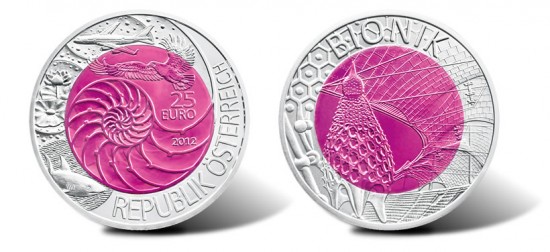2012 Austrian Bionics Silver and Niobium Bimetallic Coin Available
March 27, 2012 by Darrin Lee Unser · Leave a Comment
The Austrian Mint has issued a tenth coin in what has become one of its most popular series which features an extremely unique bimetallic composition of silver and niobium. Struck to showcase the theme of bionics, the 2012 Bionics Silver and Niobium Bimetallic Coin is available in special uncirculated condition.
At the center of these coins is a core of 99.8% pure niobium. Every coin in the series has a core of a different hue which is created through processing techniques applied to the niobium.
"Every coin in the series has a different color, but all colors are equally noble, brilliant and powerful," states Austrian Mint Managing Director, Gerhard Starsich. "I’m sure that even the tenth part of the series will be sold out quickly."
Surrounding the niobium core is a ring of 90% pure silver. The two metallic elements are fused together when struck in the coin press creating a durable, yet incredibly unique, coin.
Bionics Silver and Niobium Bimetallic Coin Design and Specifications
The obverse design of the Austrian Bionics Silver and Niobium Bimetallic Coin depicts four examples of bionics prevalent in society today. For those who do not know, bionics is the application of nature’s systems and structures to modern technology.
Among the examples shown is the image of a shark. The shark’s groove-like scale structure allows it to swim through the water with very little drag which is adapted for use in today’s aircraft and motor vehicles. Water repellency is depicted with a lotus plant known for its "self-cleaning" ability as rain drops roll across its surface, dragging dirt particles along with it. A chambered shell of the nautilus shown on the obverse has been used in modern architecture. Finally, the bird is emblematic of the mechanics of bird flight studied for the field of aviation.
Bionics in architecture is once again seen on the reverse of the coin. It portrays plankton known as a radiolarian which inspired Spanish modernist architect Antoni Gaudí. Depicted also is an interior view of Munich’s Olympic Stadium whose design was borrowed from nature.
"REPUBLIK OESTERREICH" is inscribed on the obverse for the issuing authority, Republic of Austria. It is joined by "2012" and the face value of "25 EURO." The reverse contains the inscription of "BIONIK." The obverse and reverse are the work of Austrian Mint designers Thomas Pesendorfer and Herbert Waehner.
Each coin contains 9 grams of .90 fine silver in the outer ring and 6.5 grams of .998 fine niobium in the core. The strikes have a diameter of diameter of 34mm and a total weight of 16.50 grams
Bionics Silver and Niobium Bimetallic Coins are placed in a protective slipcase then inserted in a box and presented along with a numbered certificate of authenticity. The certificate indicates the maximum mintage of the strikes which is listed at just 65,000.
Collectors may purchase the collector silver coin directly from the Austrian Mint for €51.70.
About the Austrian Mint
The Austrian Mint is situated in the heart of Vienna and is the official minting authority for Austria with a 800 year history. The Mint is the source for all Austrian Euro and Cent coins, whether they are intended for shopping, as an investment or for collection. Before the Euro, the Schilling and Groschen coins were minted, and before that — during the monarchy — Crowns, Guilders and Ducats were struck by the Austrian Mint.
![[Most Recent Quotes from www.kitco.com]](http://www.kitconet.com/images/quotes_2a.gif)





